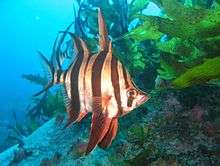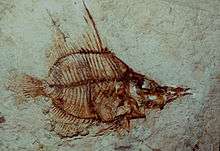Enoplosus armatus
| Enoplosus armatus Temporal range: Enoplosus 65.5–0 Ma | |
|---|---|
 | |
| Old wife, Enoplosus armatus | |
| Not evaluated (IUCN 3.1) | |
| Scientific classification | |
| Kingdom: | Animalia |
| Phylum: | Chordata |
| Class: | Actinopterygii |
| Order: | Perciformes |
| Suborder: | Percoidei |
| Family: | Enoplosidae T. N. Gill, 1893 |
| Genus: | Enoplosus Lacépède, 1802 |
| Species: | E. armatus |
| Binomial name | |
| Enoplosus armatus (J. White, 1790) | |
| Synonyms | |
| |
Enoplosus armatus, the old wife (plural: old wives), is a species of perciform fish endemic to the temperate coastal waters of Australia.[1] It is the only modern species in the family Enoplosidae.

It has a deep and compressed body and concave forehead. These features are characteristic of typical butterflyfishes.[3] However, the old wife is easily distinguished by its silver-and-black, vertical, zebra-striped coloration, and by its two prominent dorsal fins. The second dorsal fin is very long and sickle-shaped. The fish grows up to 50 cm long.

Its dorsal fins have bony, knife-like spines.[4] These have no obvious venom groove nor gland.[5] Nonetheless, the spines are widely considered to inflict a painful venom.[1]
The name "old wife" refers to the sound it makes when caught, caused by it grinding its teeth.[1][6] Other vernacular names have included "bastard dory", "zebra-fish" (also used for Girella zebra), and "double scalare".[7] It has a similar range and appearance to the Moonlighter (Tilodon sexfasciatus).[8]
History

The old wife was originally classified in the genus Chaetodon (with the typical butterflyfishes), but it is now classified as the sole modern species of its own family Enoplosidae and genus Enoplosus. Some fossils have also been added to the genus.
.jpg)
The first description of the species, one of the earliest for any Australian fish, was in 1790 by John White in his Journal of a Voyage to New South Wales[6] though some sources give George Shaw (who assisted White in the preparation of his manuscript) as the species authority.[11] White originally named it the long-spined chaetodon (Chætodon armatus) and described it as follows:[10]
Whitish Chaetodon, with seven black stripes on the body. Six spines on the dorsal fin, the third very long. This appears to be a new and very elegant species of the genus Chaetodon. The total length of the specimen was not more than four inches. The colour a silvery white, darker, and of a bluish tinge on the back; the transverse fasciae, or bands, of a deep black; the fins and tail of a pale brown. The third ray or spine of the first dorsal fin is much longer than the rest.
The species was reclassified by Lacépède into its own genus (named from "weapon" in Greek to again reflect the long spines), and was moved by Cuvier from Chaetodontidae into its own separate family within Percoidei.[12]
In 1836, Agassiz identified closely related fossils at Monte Bolca (an important fossil site in Europe) as Enoplosus pygopterus (named for its smaller fins).[12][13] Exceptionally well-preserved fossils show the basic body plan and even the zebra pattern of colouring have not changed significantly over the last 50 million years.[9]
References
- 1 2 3 Old Wife, The Australian Museum.
- ↑ Old Wife, Reef Watch Victoria. (Divers' monitoring and conservation project.)
- ↑ "Most [butterflyfish, angelfish and surgeonfish] have thin, oval or disk-shaped bodies. They typically have bright colors and patterns. Butterflyfish are usually round, small and have concave foreheads. They often have long snouts for feeding from crevices." AWARE-Fish Identification, Adventures in Diving Manual, PADI (2010).
- ↑ Carl Edmonds, Dangerous marine creatures, 1989. "Although it has been described as venomous, this apparently is of a variable nature as many lacerations from the knife-like dorsal spines have been known by this author to be relatively painless. It appears as if the pain and bleeding may be inversely related, ..." p.70
- ↑ Smith and Wheeler, Venom Evolution Widespread in Fishes, Journal of Heredity v.97 i.3 pp.206-217 (2006).
- 1 2 Morrison, Sue; Storrie, Ann (1999). Wonders of Western Waters. Como, Western Australia: Department of Conservation and Land Management. p. 119. ISBN 0-7309-6894-4.
- ↑ Agustin, Liza Q., et alii (13.07.07). "Common Names of Enoplosus armatus". Common name summary. FishBase. Retrieved 2009-01-03. Check date values in:
|date=(help) - ↑ Moonlighter, Dive Around. (Guide to marine life.)
- 1 2 The 'Lost Language' of Fishes (with captioned images), Australian Research Council's Centre of Excellence for Coral Reef Studies. Colouring patterns demonstrated to have been preserved in fish (especially old wives) from at least 50 mya.
- 1 2 White, J. 1790, Journal of a voyage to New South Wales with 65 plates of nondescript animals, birds, lizards, serpents, curious cones of trees and other natural productions.: Pl. 39. transcription at Gutenberg
- ↑ http://research.calacademy.org/redirect?url=http://researcharchive.calacademy.org/research/ichthyology/catalog/fishcatget.asp&tbl=species&spid=38950
- 1 2 L. Agassiz. 1836. Recherches Sur Les Poissons Fossiles. Tome IV (livr. 6). Imprimerie de Petitpierre, Neuchatel 53-108
- ↑ Pygon+pteron. George Roberts, An etymological and explanatory dictionary of the terms and language of geology
- Froese, Rainer, and Daniel Pauly, eds. (2006). "Enoplosidae" in FishBase. January 2006 version.
- Froese, Rainer and Pauly, Daniel, eds. (2006). "Enoplosus armatus" in FishBase. January 2006 version.
- "Enoplosus armatus". Integrated Taxonomic Information System. Retrieved 27 March 2006.
External links
![]() Media related to Enoplosus armatus at Wikimedia Commons
Media related to Enoplosus armatus at Wikimedia Commons
![]() Data related to Enoplosus armatus at Wikispecies
Data related to Enoplosus armatus at Wikispecies